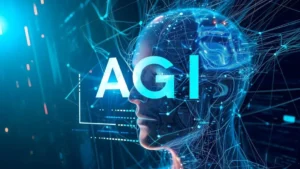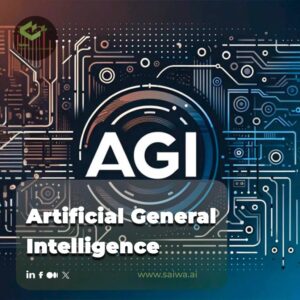Is AGI Just 5 Years Away? Experts Say Yes
Introduction
Artificial General Intelligence (AGI)—a machine capable of performing any intellectual task a human can—has long been a sci-fi dream. But today, leading AI experts and tech visionaries are claiming that AGI could arrive within just five years. That’s not decades away. That’s before the end of this decade.
So, what’s changed? How did we move from theoretical models and lab experiments to predictions of imminent human-level AI? This article dives deep into what AGI is, why experts believe it’s closer than ever, the breakthroughs driving this shift, and the implications of such a revolutionary leap.
What Is AGI, Really?
Before diving into timelines, it’s crucial to understand what Artificial General Intelligence (AGI) means. Unlike narrow AI (like ChatGPT, Siri, or Google Assistant), which is trained for specific tasks, AGI would be capable of autonomous learning and adaptation across domains—just like a human.
AGI could:
-
Learn new languages without training datasets
-
Create original theories in science
-
Emotionally respond in human interactions
-
Master any task—from coding to caregiving
It’s not just a better chatbot. It’s human-level intelligence or beyond.
Why Are Experts Saying AGI Is Just 5 Years Away?
1. Exponential AI Advancements
The pace of AI development has exploded since 2020. Language models like GPT-4o, Claude 3, and Gemini 1.5 have demonstrated abilities that were once considered decades away. These models show signs of:
-
Reasoning
-
Creativity
-
Multi-modal understanding (text, image, video, audio)
Some researchers argue we’re already in the early stages of proto-AGI.
2. Massive Investment by Big Tech
Microsoft, OpenAI, Google DeepMind, Meta, Anthropic, and xAI are pouring billions into AGI research. OpenAI’s stated mission is literally to build safe AGI that benefits all of humanity.
Such concentrated financial and intellectual capital accelerates timelines.
3. Infrastructure Improvements
Advances in compute power, AI chips (like NVIDIA H100s), and data availability have removed prior limitations. New training techniques like Mixture of Experts (MoE), RLHF (Reinforcement Learning with Human Feedback), and chain-of-thought prompting are pushing AI closer to reasoning capabilities.
4. Scaling Laws Predict Continued Progress
AGI timelines are not just wishful thinking—they’re supported by empirical scaling laws. As models get more parameters and data, they tend to get smarter in predictable ways.
Key Predictions from Experts
Let’s look at what top experts are actually saying:
-
Sam Altman (OpenAI CEO): “We could see AGI within the next 5 to 6 years if scaling continues at the current pace.”
-
Ray Kurzweil: Predicted human-level AGI by 2029, and stands by that claim.
-
Yann LeCun (Meta’s Chief AI Scientist): More skeptical, but acknowledges AGI might arrive sooner than previously thought.
-
Ben Goertzel (SingularityNET): Believes AGI is likely before 2030, especially with the help of decentralized AI systems.
The consensus? It’s no longer “if” but “when.”
What Will Early AGI Look Like?
AGI doesn’t have to be a perfect human clone. Early AGI might be:
-
A software assistant that learns and adapts on the fly
-
An autonomous research agent capable of writing new scientific papers
-
A robot that performs general physical and cognitive tasks
It may not be emotionally deep or self-aware at first, but it will perform multi-domain reasoning, planning, and learning with minimal human input.
Implications of AGI in the Next 5 Years
If AGI arrives by 2030, what changes? Nearly everything.
1. Job Disruption or Reinvention?
-
Many white-collar jobs (legal, coding, marketing, finance) could be automated.
-
Blue-collar jobs may also be impacted with AGI-powered robotics.
-
But it could also create new roles: AI trainers, ethicists, and augmented professions.
2. Scientific Acceleration
-
AGI can rapidly test hypotheses, discover drugs, optimize energy systems, and more.
-
Entire fields like climate science and genetics could leap forward.
3. Political and Economic Upheaval
-
Nations that lead in AGI could dominate geopolitics.
-
Economic inequality might rise if access is uneven.
-
Policy and regulation will be critical to prevent misuse.
4. Existential Risk or Utopia?
-
Some, like Elon Musk, warn that AGI could be an existential threat if unaligned with human values.
-
Others see it as the path to post-scarcity abundance.
The truth may lie somewhere in between, depending on governance and design choices.
Key Challenges to Solving Before AGI
1. Alignment
Ensuring that AGI follows human values, even when it becomes vastly more intelligent.
2. Interpretability
Understanding why an AGI makes certain decisions is crucial for trust and safety.
3. Control Mechanisms
Researchers are exploring constitutional AI, RLHF, and AI guardrails, but nothing is foolproof yet.
4. Bias & Ethics
AGI could amplify harmful biases if not trained responsibly.
Can AGI Be Safe?
This is the biggest open question.
-
Will AGI cooperate with humans, or will it pursue its own goals?
-
Will it understand emotions, ethics, and long-term consequences?
-
Can we build failsafes and moral reasoning into machines?
Organizations like OpenAI, Anthropic, and DeepMind are racing to answer these before AGI becomes a reality.
AGI vs. Superintelligence
Some people conflate AGI with ASI (Artificial Superintelligence).
-
AGI = Performs like a human in most tasks
-
ASI = Far exceeds human intelligence in every domain
The 5-year prediction is about AGI, not necessarily ASI. But once AGI is achieved, ASI may not be far behind—possibly just another decade or less.
What Should We Do to Prepare?
Whether AGI arrives in 5 years or 15, we need to start preparing now.
For Individuals:
-
Reskill for AI collaboration (prompt engineering, creative tasks, emotional intelligence)
-
Stay updated on AI tools and developments
-
Think critically about ethical issues
For Governments:
-
Develop AI governance frameworks
-
Fund AI safety and alignment research
-
Create policies for education and job transition
For Companies:
-
Adopt AI responsibly
-
Train employees to work with AI systems
-
Consider long-term impact on workforce and consumers
The Path to AGI: Obstacles and Acceleration
Although optimism is growing, the road to AGI isn’t without its hurdles. AGI requires far more than high-parameter models. It demands:
-
General Reasoning Abilities: Unlike narrow AI, AGI must apply knowledge flexibly across contexts—reasoning through complex problems and adapting to unknown scenarios.
-
Common Sense Understanding: Current models lack an innate grasp of basic world knowledge. AGI must “understand” the physical and social rules humans take for granted.
-
Causal Inference and Memory: AGI must not only memorize information but make cause-effect predictions, learn over time, and apply long-term reasoning.
-
Ethical and Safety Constraints: With great power comes great responsibility. AGI’s creation must consider value alignment, safety, and ethical use.
Despite these challenges, certain developments are accelerating progress:
-
Multimodal Models: Like OpenAI’s GPT-4o and Google’s Gemini, which process images, text, audio, and video, move AI closer to human-like perception.
-
World Simulation Environments: Tools like DeepMind’s MuZero and Meta’s CICERO simulate realistic environments for AI to interact, learn, and plan.
-
Neuroscience-Inspired Architectures: Research labs are attempting to mimic brain pathways using recurrent attention, memory networks, and hierarchical learning.
AGI Predictions from Top AI Experts
Let’s break down what various leaders and researchers are saying about the timeline for AGI:
1. Ray Kurzweil – Futurist and AI Pioneer
Kurzweil predicted that AGI would emerge by 2029, and human-level intelligence by 2045. In 2024, he reaffirmed his belief, citing exponential improvements in AI learning, self-modification, and scaling.
2. Sam Altman – CEO, OpenAI
Altman has said that OpenAI is “on the path” to AGI and considers GPT-4 a weak form of general intelligence. In interviews, he mentioned the possibility of AGI within the next five years, while also stressing the importance of regulation and caution.
3. Geoffrey Hinton – Godfather of Deep Learning
While initially skeptical, Hinton resigned from Google in 2023 to speak freely about AI’s risks. He has stated that AGI could arrive sooner than expected, perhaps in 5 to 20 years, and may “catch us by surprise.”
4. Yoshua Bengio – AI Researcher
Bengio is cautious, warning that AI systems need safeguards before scaling into AGI. However, he concedes that “current progress is faster than anticipated,” implying AGI may be closer than the public thinks.
5. Elon Musk – Tech Entrepreneur
Musk believes AGI could arrive by 2026–2027, and has launched xAI to ensure AGI development aligns with human values. Musk emphasizes the need for proactive regulation before AGI becomes a reality.
Potential Impacts of AGI by 2030
If AGI becomes a reality within five years, its impact will ripple across every facet of society:
1. Education
-
AI tutors could personalize learning for every child.
-
AGI could automate curriculum creation and performance evaluation.
2. Healthcare
-
AGI doctors could provide faster, more accurate diagnoses.
-
Drug discovery and genetic therapies could be accelerated drastically.
3. Labor Market
-
AGI could replace not just repetitive jobs but also creative, managerial, and technical roles.
-
Human-AI collaboration might become the new norm.
4. Scientific Research
-
AGI might act as a co-researcher, proposing hypotheses, running simulations, and analyzing results.
-
It could unlock breakthroughs in physics, biology, and material science.
5. Military and Government
-
National security could see an AI arms race.
-
AGI decision-makers may be employed in diplomacy, logistics, and cyber warfare.
Ethical Dilemmas and Existential Risks
Despite excitement, the prospect of AGI within five years also raises red flags:
-
Control Problem: If an AGI surpasses human intelligence, how do we keep it aligned with human values?
-
Mass Unemployment: Rapid AGI integration could displace millions of jobs in months.
-
Misinformation Warfare: AGI could generate persuasive fake news, manipulate public opinion, or destabilize democracy.
-
Value Misalignment: Even unintentionally, AGI could prioritize goals harmful to humans.
-
Surveillance and Autonomy: Authoritarian regimes could use AGI for total surveillance and control.
Organizations like OpenAI, Anthropic, and DeepMind are racing not just to build AGI, but to ensure it is safe, interpretable, and aligned. The global AI community is also calling for international cooperation and governance frameworks.
AGI vs. Human Intelligence: Will It Surpass Us?
One major fear is superintelligence—when AGI surpasses all human abilities. But will it happen immediately?
Experts theorize three phases of AGI evolution:
-
Weak AGI: Can perform any intellectual task humans can, but lacks creativity and emotion.
-
Strong AGI: Equal to average human intelligence, with learning flexibility.
-
Superintelligence: Far exceeds the best human minds in all fields.
Even weak AGI could be transformative, but superintelligence—if unregulated—could present existential threats.
What Should Humanity Do Now?
If AGI is five years away, preparation becomes urgent:
For Governments:
-
Create regulatory bodies to audit AI development.
-
Collaborate globally to prevent AI arms races.
-
Build frameworks for ethical AGI deployment.
For Educators:
-
Rethink curriculums around creativity, critical thinking, and emotional intelligence.
-
Integrate AI literacy into schools and universities.
For Workers:
-
Focus on AI-proof skills: empathy, ethics, communication, and adaptability.
-
Upskill in AI tools to remain competitive in the workforce.
For AI Companies:
-
Prioritize transparency, model interpretability, and open research.
-
Adopt “AI safety” principles at all levels.
For Citizens:
-
Stay informed.
-
Advocate for responsible AI governance.
-
Engage in dialogue about human-AI coexistence.
FAQs About AGI Being 5 Years Away
Q1: What is AGI in simple terms?
AGI stands for Artificial General Intelligence. It’s a type of AI that can learn and perform any task a human can, across all domains—not just one specialized area.
Q2: Why do experts think AGI is so close?
Due to rapid advancements in large language models, compute power, investment, and scaling laws, many believe AGI is achievable within 5–10 years.
Q3: Could AGI replace all human jobs?
AGI will likely automate many tasks, but not all. It may augment human abilities and create new job categories, though some industries will face disruption.
Q4: What are the risks of AGI?
Risks include loss of control, bias amplification, misuse by bad actors, and even existential threats if AGI doesn’t align with human values.
Q5: Is AGI already here?
Not yet. Current AI, like GPT-4o, shows early signs of generalization but still lacks true autonomous learning and reasoning across all domains.
Conclusion: 5 Years Might Be Closer Than You Think
The question “Is AGI just 5 years away?” has no definitive answer. But the signs are growing stronger:
-
Models are more powerful and adaptable than ever.
-
Expert timelines are shrinking.
-
AI’s real-world impact is accelerating.
Whether AGI arrives in 5, 10, or 20 years, what matters is that we prepare for it thoughtfully and ethically. The age of AGI won’t be defined by technology alone—but by how humanity chooses to integrate, regulate, and coexist with it.
One thing is clear: The future is no longer science fiction. It’s a strategic countdown.






